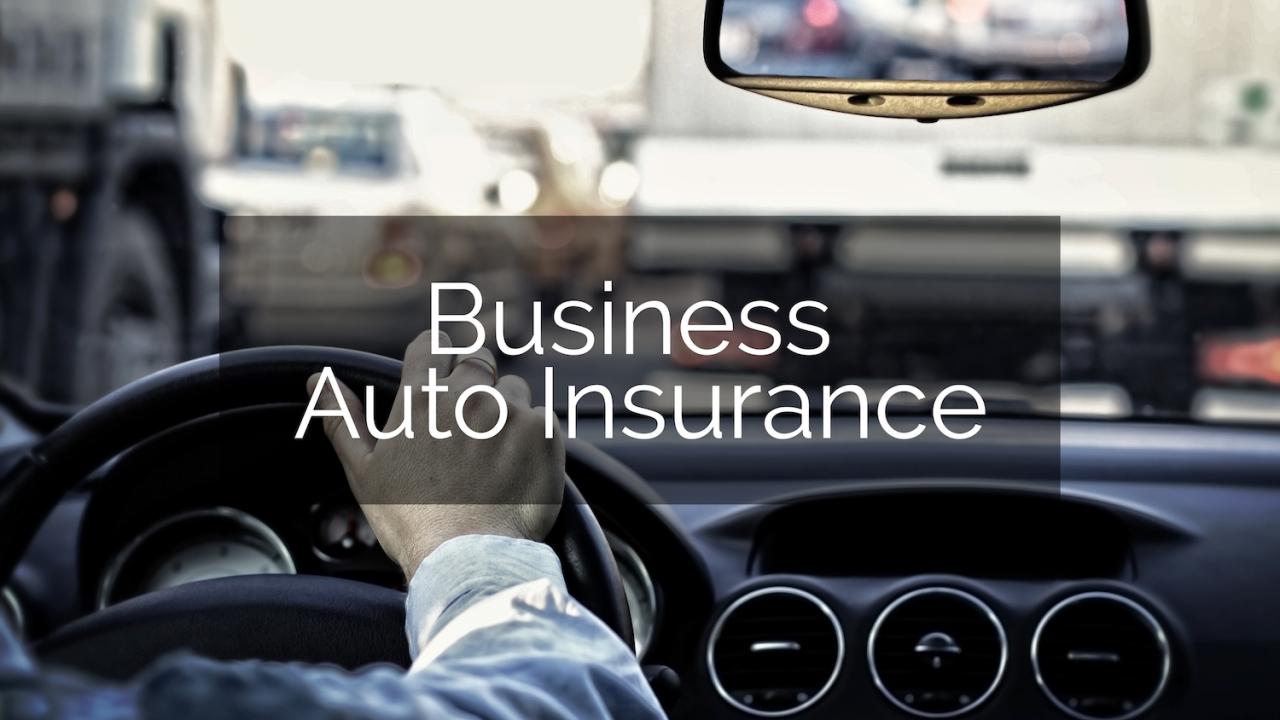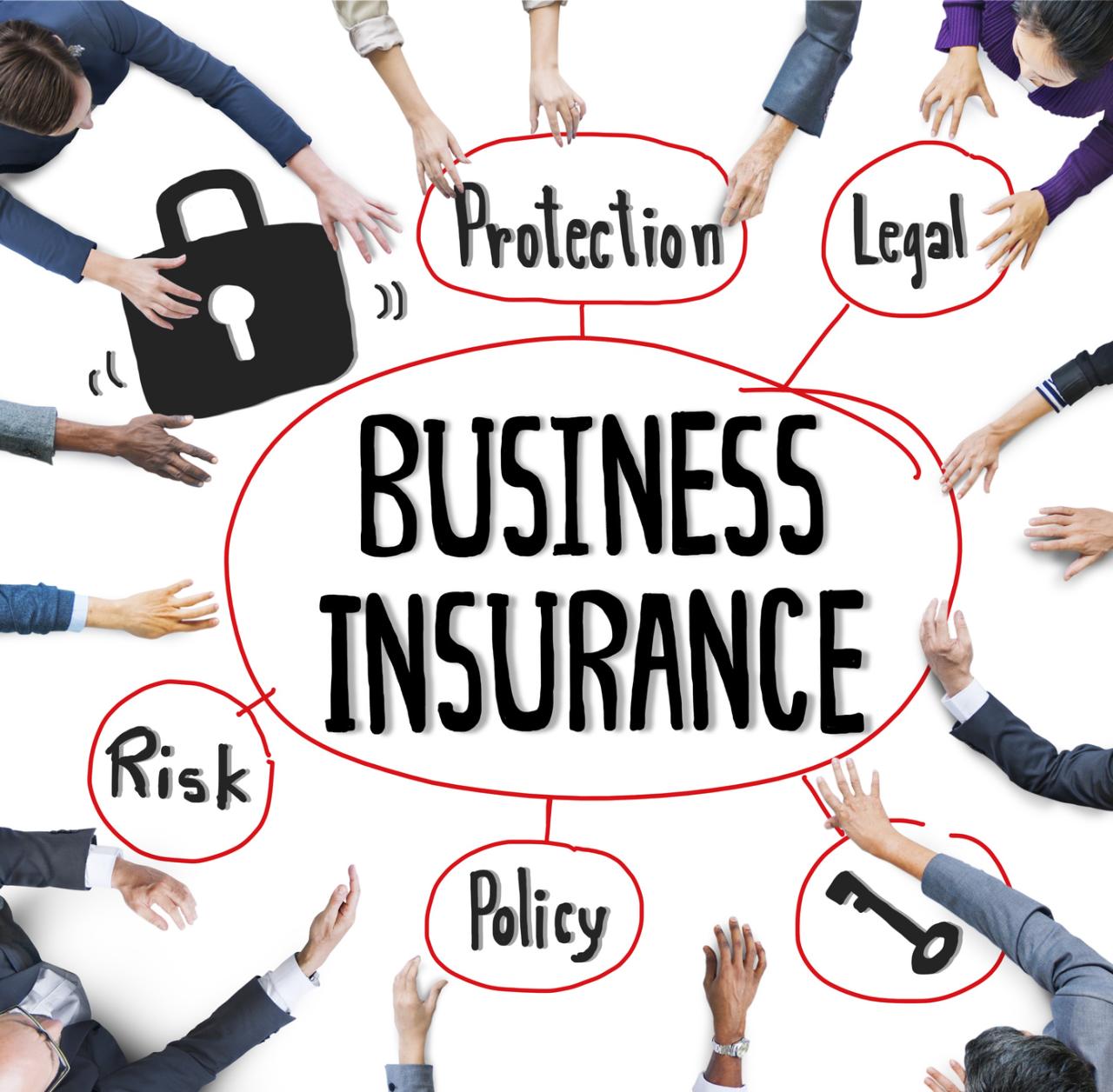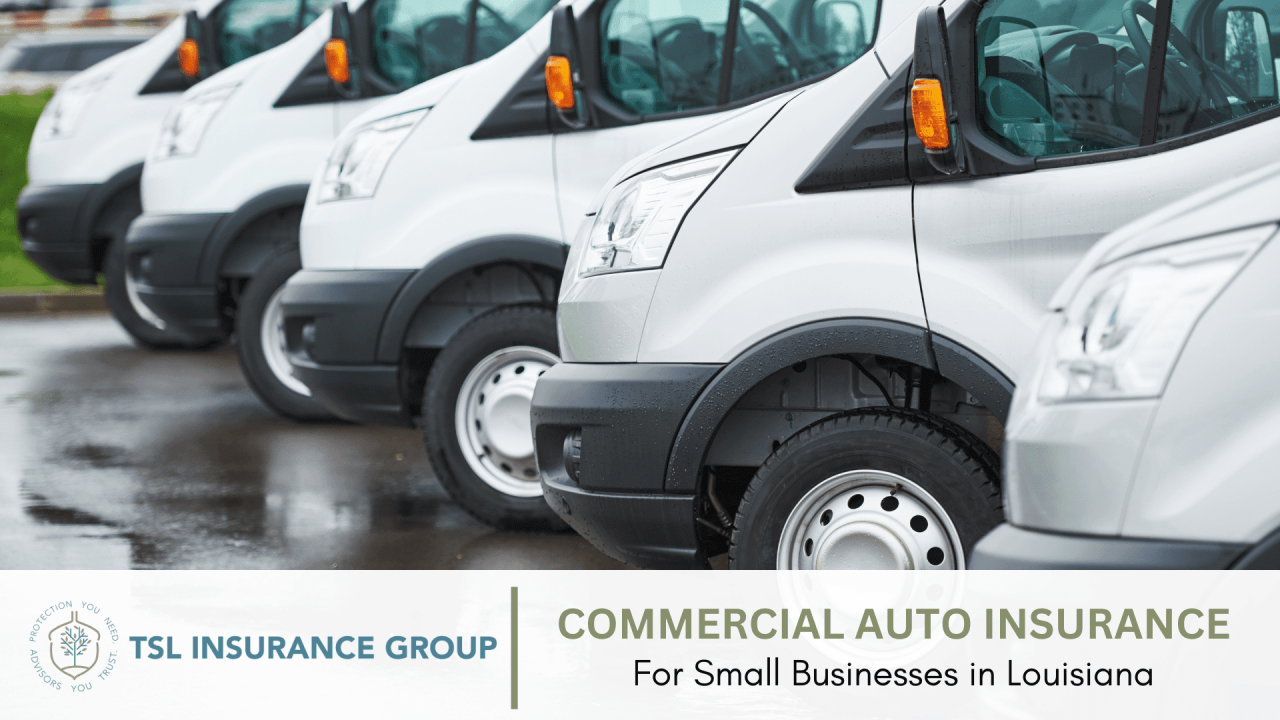For small business owners, vehicles are often more than just transportation; they are essential tools for delivering goods, services, and employees. But with this reliance comes risk. Accidents, theft, and liability claims can cripple a small business, making adequate auto insurance a critical component of financial stability.
This guide explores the world of small business auto insurance, covering everything from understanding different coverage types to finding the right provider and managing risk. Whether you run a delivery service, a construction company, or any other business that relies on vehicles, this information is essential for protecting your assets and ensuring your business’s continued success.
Introduction to Small Business Auto Insurance

Small businesses rely heavily on vehicles for their operations, making auto insurance a crucial aspect of their risk management strategy. Unlike personal auto insurance, small business auto insurance caters to the unique needs and risks associated with using vehicles for commercial purposes. This type of insurance provides coverage for a range of potential liabilities and financial losses that can arise from accidents, theft, or other incidents involving business vehicles.
The Unique Needs of Small Businesses
Small businesses often have specific requirements for auto insurance that go beyond the standard coverage offered to individual drivers. These needs arise from the nature of their operations, the types of vehicles used, and the potential risks they face.
- Commercial Use: Small businesses use vehicles for various commercial purposes, including transporting goods, services, or employees. This type of use exposes them to different risks compared to personal vehicles used for commuting or leisure activities.
- Multiple Drivers: Many small businesses have multiple employees who drive company vehicles. This increases the likelihood of accidents and the potential for claims.
- Valuable Assets: Businesses often invest in expensive vehicles, such as trucks, vans, or specialized equipment. Adequate insurance coverage is essential to protect these assets from damage or loss.
- Liability Exposure: Small businesses face significant liability risks when their vehicles are involved in accidents. They could be held responsible for injuries, property damage, or other losses caused by their employees or vehicles.
Types of Coverage for Small Business Auto Insurance
Small business auto insurance is a crucial part of protecting your business from financial losses arising from accidents or other incidents involving your company vehicles. Understanding the various types of coverage available can help you choose the right policy to meet your specific needs.
Liability Coverage
Liability coverage is essential for any business operating vehicles. It protects your business from financial losses resulting from accidents caused by your employees or company vehicles. This coverage can pay for damages to other vehicles or property, as well as medical expenses for injured parties.
For example, if your delivery driver causes an accident that results in injuries to another driver and damages to their vehicle, liability coverage would help cover the costs of medical bills and repairs.
Collision Coverage
Collision coverage protects your business from financial losses due to damage to your company vehicles caused by accidents. This coverage pays for repairs or replacement costs, regardless of who is at fault.
If your company vehicle is involved in a collision, even if your driver is not at fault, collision coverage can help pay for repairs or replacement.
Comprehensive Coverage
Comprehensive coverage protects your business from financial losses due to damage to your company vehicles caused by events other than collisions, such as theft, vandalism, fire, or natural disasters.
If your company vehicle is stolen or damaged by a storm, comprehensive coverage can help pay for repairs or replacement.
Uninsured/Underinsured Motorist Coverage
Uninsured/underinsured motorist coverage protects your business from financial losses resulting from accidents caused by drivers without adequate insurance or no insurance at all.
If your company vehicle is hit by an uninsured driver, this coverage can help pay for medical expenses and vehicle repairs.
Medical Payments Coverage
Medical payments coverage pays for medical expenses for your employees and passengers in your company vehicles, regardless of who is at fault.
If your employee is injured in an accident while driving a company vehicle, medical payments coverage can help pay for their medical bills.
Rental Reimbursement Coverage
Rental reimbursement coverage helps pay for the cost of a rental vehicle if your company vehicle is damaged or stolen and cannot be used.
If your company vehicle is being repaired, this coverage can help you keep your business running by covering the cost of a rental vehicle.
Towing and Labor Coverage
Towing and labor coverage pays for the cost of towing your company vehicle to a repair shop and for labor costs if your vehicle breaks down.
If your company vehicle breaks down on the road, this coverage can help you get it towed to a repair shop.
Personal Injury Protection (PIP)
PIP coverage pays for medical expenses and lost wages for your employees and passengers in your company vehicles, regardless of who is at fault.
If your employee is injured in an accident while driving a company vehicle, PIP coverage can help pay for their medical bills and lost wages.
Factors Affecting Small Business Auto Insurance Premiums

Your small business auto insurance premium is determined by a variety of factors, each playing a significant role in shaping the final cost. Understanding these factors can help you make informed decisions to potentially lower your premium.
Vehicle Type
The type of vehicle your business uses heavily influences the premium.
- Commercial Vehicles: Trucks, vans, and other commercial vehicles generally have higher premiums due to their increased risk of accidents and potential for larger losses.
- Passenger Vehicles: Cars and SUVs used for business purposes typically have lower premiums than commercial vehicles but still carry a higher rate than personal vehicles.
Driver History
Your drivers’ driving records significantly impact your insurance premiums.
- Clean Driving Record: Drivers with no accidents, violations, or DUI convictions enjoy lower premiums.
- Accidents and Violations: Accidents and traffic violations, especially those involving at-fault accidents, can lead to significantly higher premiums.
Business Operations
The nature of your business operations also plays a role in determining your premium.
- High-Risk Operations: Businesses involved in hazardous materials transportation, heavy construction, or frequent long-distance travel face higher premiums due to increased accident risk.
- Low-Risk Operations: Businesses with minimal vehicle usage, low-risk activities, and careful driving practices typically qualify for lower premiums.
Location
The location where your business operates impacts your premiums.
- Urban Areas: Higher traffic density and increased accident rates in urban areas can lead to higher premiums.
- Rural Areas: Lower traffic volumes and fewer accident risks in rural areas may result in lower premiums.
Other Factors
Beyond the primary factors discussed above, several other elements contribute to your insurance premium.
- Insurance Coverage: The level of coverage you choose, such as liability limits, collision coverage, and comprehensive coverage, will affect your premium.
- Safety Features: Vehicles equipped with advanced safety features, like anti-lock brakes, airbags, and stability control, may qualify for discounts.
- Claims History: Previous claims filed by your business can impact future premiums.
- Credit Score: In some states, insurers consider your credit score as a factor in determining your premium.
Choosing the Right Small Business Auto Insurance Provider

Finding the right small business auto insurance provider is crucial to protecting your business assets and ensuring financial security in case of accidents or incidents.
A comprehensive insurance policy can safeguard your business from potential liabilities and costs associated with vehicle-related events.
Comparing Insurance Providers
It’s essential to compare different insurance providers to find the best fit for your business needs and budget.
Consider these key factors when comparing providers:
- Coverage Options: Evaluate the range of coverage options offered by each provider, ensuring they align with your specific business requirements.
Consider factors such as liability limits, comprehensive and collision coverage, uninsured/underinsured motorist coverage, and rental car reimbursement. - Pricing: Obtain quotes from multiple providers to compare premiums and identify the most competitive rates.
Consider factors like deductibles, coverage levels, and discounts offered. - Customer Service: Assess the quality of customer service provided by each insurer.
Consider factors such as responsiveness, helpfulness, and ease of communication. - Financial Stability: Research the financial strength and stability of each provider.
Consider factors like ratings from agencies like AM Best or Standard & Poor’s to ensure they can fulfill their financial obligations in case of a claim.
Key Features and Benefits of Different Insurance Providers
The following table summarizes key features and benefits of some leading small business auto insurance providers:
| Provider | Coverage Options | Pricing | Customer Service | Financial Stability |
|---|---|---|---|---|
| Provider A | Comprehensive coverage options, including high liability limits and uninsured motorist coverage | Competitive rates with discounts for safe driving and multiple policies | Highly rated customer service with responsive agents and online resources | Strong financial rating with a history of claim payment |
| Provider B | Tailored coverage options for specific business needs, including cargo insurance and roadside assistance | Flexible payment plans and discounts for fleet vehicles | Excellent online platform with 24/7 access to policy information and claims support | Solid financial standing with a long track record of stability |
| Provider C | Basic coverage options with competitive pricing and flexible payment options | Affordable rates with discounts for good driving records and business memberships | Easy-to-use online portal and phone support with limited hours of operation | Stable financial position with a history of paying claims promptly |
Importance of Understanding Policy Documents
Your small business auto insurance policy is a contract outlining the terms and conditions of coverage. It’s essential to understand the details of your policy to ensure you have adequate protection and avoid any surprises later.
Key Sections in the Policy
Reviewing your policy thoroughly is crucial to understand your coverage. Here are some key sections to focus on:
- Declarations Page: This page summarizes your policy, including the insured’s name, policy number, coverage limits, and premiums. It’s the first page of your policy and provides an overview of your coverage.
- Coverage Details: This section explains the specific types of coverage included in your policy, such as liability, collision, comprehensive, and uninsured/underinsured motorist coverage. It Artikels the limits and exclusions for each coverage.
- Exclusions and Limitations: This section lists specific situations or events not covered by your policy. It’s crucial to understand these limitations to avoid unexpected costs during a claim.
- Deductibles: Your policy will Artikel the deductible amounts for different types of coverage. Deductibles are the amounts you pay out-of-pocket before your insurance kicks in.
- Conditions: This section Artikels the terms and conditions you must adhere to maintain coverage. It might include requirements for reporting claims, cooperating with the insurer, and maintaining your vehicle.
Understanding Policy Terms
Insurance policies use specific terminology that can be confusing. Here are some common terms and their implications:
- Premium: The amount you pay to your insurer for coverage. Premiums can vary depending on factors like your driving record, vehicle type, and coverage limits.
- Deductible: The amount you pay out-of-pocket before your insurance covers the remaining costs of a claim. A higher deductible typically results in lower premiums.
- Coverage Limits: The maximum amount your insurer will pay for a covered claim. It’s essential to ensure your coverage limits are sufficient to cover potential losses.
- Exclusions: Situations or events not covered by your policy. Understanding exclusions can help you avoid surprises during a claim.
- Cancellation: The process of terminating your policy. Understanding the cancellation process is crucial if you decide to switch providers or no longer need coverage.
Filing a Claim with Small Business Auto Insurance

A smooth and efficient claim filing process is crucial for minimizing disruption to your business operations after an accident. It’s essential to understand the steps involved and how to effectively communicate with your insurance provider to ensure a timely and fair resolution.
Steps Involved in Filing a Claim
The claim filing process typically involves several steps, starting with immediate notification of the accident.
- Report the Accident: Immediately notify your insurance provider of the accident, providing details like the date, time, location, and parties involved. This is often done through a phone call or online portal.
- File a Claim: Once you’ve reported the accident, you’ll need to file a formal claim with your insurance company. This usually involves completing a claim form, providing documentation, and potentially meeting with an insurance adjuster.
- Gather Information and Documentation: To support your claim, you should gather essential documentation such as police reports, witness statements, photographs of the damage, and repair estimates.
- Cooperate with the Insurance Adjuster: An insurance adjuster will investigate the accident and assess the damages. It’s important to cooperate with them, providing accurate information and responding to their requests promptly.
- Negotiate a Settlement: Once the insurance adjuster has completed their investigation, they will present you with a settlement offer. You have the right to negotiate this offer, and it’s advisable to seek legal counsel if you’re unsure about the terms.
Tips for Documenting the Claim Process Effectively
Proper documentation is essential for a successful claim.
- Take Detailed Notes: Keep a detailed record of all interactions with your insurance provider, including dates, times, names of individuals you spoke with, and the content of conversations.
- Gather Supporting Documentation: Collect all relevant documentation, such as repair estimates, police reports, medical bills, and witness statements.
- Take Clear Photographs: Take photographs of the damage to your vehicle, the accident scene, and any injuries sustained.
- Keep Copies of All Documents: Maintain copies of all documents related to your claim, including correspondence with your insurance provider.
Communicating with the Insurance Provider During the Claim Process
Effective communication with your insurance provider is crucial throughout the claim process.
- Be Prompt and Clear: Respond to all requests from your insurance provider promptly and provide clear and concise information.
- Maintain Professionalism: Even in stressful situations, it’s important to maintain a professional and respectful demeanor in all communications with your insurance provider.
- Be Persistent: If you encounter delays or issues with your claim, don’t hesitate to follow up with your insurance provider and advocate for your interests.
- Seek Legal Counsel if Needed: If you feel that your claim is not being handled fairly or if you’re unsure about the terms of your policy, consider seeking legal counsel.
Managing Risk and Preventing Accidents
Minimizing risk and preventing accidents are crucial for any small business that operates vehicles. A proactive approach to safety can significantly reduce the likelihood of accidents, leading to lower insurance premiums and a safer work environment for employees.
Vehicle Maintenance
Regular vehicle maintenance is essential for preventing accidents. Well-maintained vehicles are less likely to break down or experience mechanical failures that could lead to accidents.
- Regular Inspections: Scheduled maintenance inspections should include checking fluids, tires, brakes, lights, and other essential components.
- Tire Maintenance: Proper tire pressure, tread depth, and wheel alignment are critical for safe driving.
- Engine Maintenance: Regular oil changes, air filter replacements, and tune-ups ensure optimal engine performance and reduce the risk of breakdowns.
- Brakes: Inspect brake pads and rotors regularly for wear and tear. Ensure brakes are functioning properly.
Driver Safety
Implementing driver safety programs and training is essential for minimizing the risk of accidents.
- Driver Training: Providing defensive driving courses can equip drivers with the skills and knowledge to handle challenging driving situations safely.
- Driving Records: Monitor driver records for any violations or accidents. Address any issues promptly and consider implementing disciplinary measures if necessary.
- Cell Phone Use: Enforce a strict policy prohibiting cell phone use while driving, except for hands-free devices.
- Speeding: Promote adherence to speed limits and discourage aggressive driving behavior.
- Fatigue Management: Establish policies that discourage driving when fatigued. Encourage drivers to take breaks and get sufficient rest.
Fleet Management
Effective fleet management practices can contribute to a safer driving environment.
- Vehicle Tracking: Use GPS tracking devices to monitor vehicle locations and driving habits.
- Route Optimization: Plan routes efficiently to minimize driving time and reduce the likelihood of accidents.
- Pre-Trip Inspections: Implement a pre-trip inspection checklist for drivers to ensure vehicles are in safe operating condition before each trip.
The Role of Technology in Small Business Auto Insurance
The insurance industry is undergoing a significant transformation, with technology playing a pivotal role in shaping the future of small business auto insurance. Advancements in data analytics, artificial intelligence (AI), and telematics are revolutionizing how insurers assess risk, price policies, and provide personalized services.
Use of Telematics Devices and Data Analytics in Risk Assessment and Pricing
Telematics devices, such as GPS trackers and smartphone apps, collect driving data that can be analyzed to create a more accurate picture of individual driving habits. This data can be used to assess risk more precisely and provide discounts to safe drivers. For instance, insurers can track factors like speed, braking patterns, and mileage to identify drivers who exhibit safe driving behaviors and offer them lower premiums. Data analytics also helps insurers understand emerging trends in driving behavior and develop more targeted risk management strategies.
Innovative Insurance Solutions Emerging in the Market
The integration of technology has led to the emergence of innovative insurance solutions that are tailored to the specific needs of small businesses.
- Usage-Based Insurance (UBI): UBI programs use telematics data to calculate premiums based on actual driving behavior, rewarding safe drivers with lower rates. These programs offer flexibility and cost savings for businesses with diverse driving needs, such as delivery services or field technicians.
- Pay-Per-Mile Insurance: This model charges premiums based on the number of miles driven, offering a cost-effective option for businesses with vehicles that have low mileage. This can be particularly beneficial for seasonal businesses or those with vehicles used for occasional trips.
- AI-Powered Claims Processing: AI algorithms are being used to automate claims processing, reducing the time it takes to settle claims and improving efficiency. This can be particularly valuable for small businesses that may not have dedicated claims teams.
- Smart Contracts: Smart contracts leverage blockchain technology to automate insurance policy execution and claims processing, reducing administrative costs and increasing transparency. This can streamline the insurance process and make it more efficient for small businesses.
Legal Considerations for Small Business Auto Insurance
Small business owners need to understand the legal considerations involved in auto insurance to ensure compliance and minimize potential risks. Navigating the legal landscape of auto insurance is crucial for protecting your business and avoiding costly legal issues.
Compliance with State and Federal Regulations
Compliance with state and federal regulations is paramount for small business auto insurance. These regulations govern various aspects of insurance, including minimum coverage requirements, policy terms, and claims procedures.
- State Regulations: Each state has its own set of auto insurance laws, dictating minimum coverage requirements for businesses operating within its borders. These requirements typically include liability coverage, personal injury protection (PIP), and uninsured/underinsured motorist (UM/UIM) coverage.
- Federal Regulations: While federal regulations are less common, they may apply to specific situations, such as interstate commerce or certain types of vehicles. For example, the Federal Motor Carrier Safety Administration (FMCSA) sets safety standards for commercial motor vehicles operating in interstate commerce, including insurance requirements.
Legal Issues Related to Accidents or Claims
Accidents involving business vehicles can lead to a range of legal issues, including liability claims, property damage disputes, and personal injury lawsuits.
- Liability Claims: In the event of an accident, the business owner may be held liable for damages caused by their employee. Understanding the scope of liability coverage and the process for handling claims is crucial.
- Property Damage Disputes: Accidents can result in damage to other vehicles, property, or infrastructure. Resolving these disputes may involve insurance claims, legal negotiations, or even litigation.
- Personal Injury Lawsuits: If an accident results in injuries to others, the injured parties may file personal injury lawsuits against the business owner. This can lead to significant legal costs and potential financial settlements.
Future Trends in Small Business Auto Insurance
The landscape of small business auto insurance is undergoing a rapid transformation, driven by technological advancements, evolving risk profiles, and changing consumer expectations. This evolution is poised to significantly impact coverage, pricing, and the overall experience for small businesses.
The Rise of Autonomous Vehicles
Autonomous vehicles (AVs) are poised to revolutionize the automotive industry and, in turn, reshape the landscape of small business auto insurance. AVs are expected to significantly reduce accidents due to their advanced sensors and algorithms, leading to lower insurance premiums.
“By 2030, AVs are expected to reduce the number of accidents by 90%, resulting in a substantial decline in insurance claims.” – McKinsey & Company
However, the transition to AVs presents challenges for insurers. The liability for accidents involving AVs is still being debated, and new insurance models are needed to address the unique risks associated with these vehicles.
The Impact of Artificial Intelligence
AI is playing an increasingly important role in small business auto insurance. AI-powered algorithms are being used to assess risk, personalize pricing, and automate claims processing.
“AI-driven risk assessment can analyze driving data and identify patterns that traditional methods miss, leading to more accurate and personalized premiums.” – Accenture
AI can also help insurers detect fraud, improve customer service, and optimize their operations.
Personalized Pricing and Coverage
The use of telematics and data analytics is enabling insurers to offer more personalized pricing and coverage options. Telematics devices can track driving behavior, allowing insurers to reward safe drivers with lower premiums.
“Insurers are using telematics data to offer discounts to drivers who maintain a safe driving record, demonstrating the value of good driving behavior.” – The Zebra
This data-driven approach allows insurers to tailor coverage to the specific needs of individual businesses, offering greater flexibility and cost-effectiveness.
Increased Focus on Risk Management
Insurers are increasingly focusing on risk management and accident prevention to mitigate costs and improve customer outcomes. This involves promoting safe driving practices, implementing driver training programs, and leveraging technology to identify potential hazards.
“Proactive risk management strategies, such as driver training and vehicle maintenance programs, can help small businesses reduce accidents and lower insurance costs.” – National Safety Council
By taking a holistic approach to risk management, insurers can help small businesses create a safer environment for their employees and customers.
Ultimate Conclusion

Navigating the complex landscape of small business auto insurance requires careful planning and a proactive approach. By understanding your needs, comparing options, and taking steps to minimize risk, you can secure the right coverage for your business and its vehicles. Remember, a comprehensive insurance policy is not just a financial safeguard; it’s an investment in your business’s long-term viability and peace of mind.

